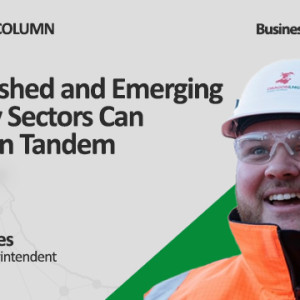Established and Emerging Energy Sectors Can Work in Tandem


Having grown up in Milford Haven, I've seen the role that oil and gas has played in shaping this part of Wales. Today, that legacy continues through liquefied natural gas (LNG), and I believe it will remain an essential part of our energy mix for years to come. At Dragon LNG, we're proud to play a central role in the UK's energy resilience.
Our facility can supply up to 10% of the country's gas demand, offering the flexibility and responsiveness needed to keep homes warm and businesses running. But this isn't just about legacy energy. It's about how we transition - practically and fairly - towards a low-carbon future.
That's where the Celtic Freeport[1] comes in. As part of the Freeport, we're working to decarbonise our own operations while contributing to the wider shift in South Wales and beyond. LNG has an ongoing role to play, but it can - and must - sit alongside renewables and new technologies if we are serious about delivering a just transition.
At Dragon, we've taken meaningful steps to reduce our carbon footprint. Our Dragon Energy initiative is already delivering results. We've installed more than 18,000 solar panels, generating around 8% of our terminal's energy.
Wind turbines are about to be added, and together these renewable sources will soon provide nearly half of our operational power. That translates to a reduction of around 11,500 tonnes of CO2 emissions every year. These are real changes, not future aspirations.
They show that LNG infrastructure and renewable energy can work in tandem. It's not about turning off one tap before another is ready. It's about sequencing, and using what we already have to accelerate the shift.
The carbon capture project we're developing with RWE is another example. It will see pipelines laid across the seabed at Milford Haven to capture emissions from LNG-powered generation that would otherwise be released into the atmosphere. The captured carbon would be liquefied and shipped away, using many of the same skills, vessels and infrastructure that support today's energy industry.
This isn't a competing model; it's a complementary one. The Celtic Freeport[2] is helping to bring all of this together. It provides the framework to connect projects, people and opportunities.
Milford Haven's port infrastructure and marine capabilities are already well established. We can accommodate some of the world's largest tankers. The skills in our ports - pilots, tugs, vessel traffic services - are world-class.
Those skills are transferrable. With the right support, they can serve not only the LNG industry, but new sectors like floating offshore wind, hydrogen and carbon capture too. There's real potential here, and the prize is not just emissions reduction, but prosperity.
I remember what it felt like when the pipelines for Dragon LNG were being laid in the late 2000s. There was energy in the local economy - people could see the benefits. I believe that the next wave of projects, from carbon capture to renewables, can do the same again.
But to get there, we need a coordinated push. We need investment in infrastructure, especially for carbon capture and hydrogen. We need clarity and stability in policy so that investors can proceed with confidence.
And we need skills investment - support for apprenticeships, education and retraining so that people already working in traditional industries can make the transition into emerging sectors. Most of all, we need to back South Wales. We have the ports, we have the people, and we have the potential.
The dominoes are lined up. But we need the right people around the right tables making the right decisions. If we can get that alignment, we can demonstrate what a just transition really looks like.
A win for one Freeport project should be seen as a win for all, because it brings momentum, skills and confidence to the region as a whole. There's no single solution to the energy transition. It's not about choosing between LNG and renewables but understanding how they can work together in a practical, phased approach.
That's the perspective we bring at Dragon LNG. We're proud of our role in the UK's energy security, but we're equally proud of the work we're doing to decarbonise and diversify. This is the model we believe in - collaborative, connected and ready to deliver.
Let's keep the spotlight on South Wales. Let's back the ports that are ready to deliver. And let's get these projects across the line.
Aled Davies talks about this and more in the Celtic Freeport[3]: Unlocking Opportunity podcast episode How the Celtic Freeport[4] is Powering Regional Decarbonisation. Listen to the podcast here.[5]
References
- ^ Celtic Freeport - Homepage (businessnewswales.com)
- ^ Celtic Freeport - Homepage (businessnewswales.com)
- ^ Celtic Freeport - Homepage (businessnewswales.com)
- ^ Celtic Freeport - Homepage (businessnewswales.com)
- ^ Listen to the podcast here. (businessnewswales.com)